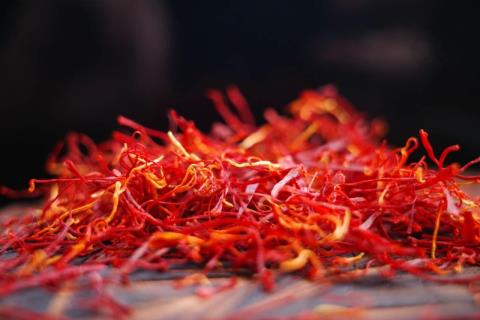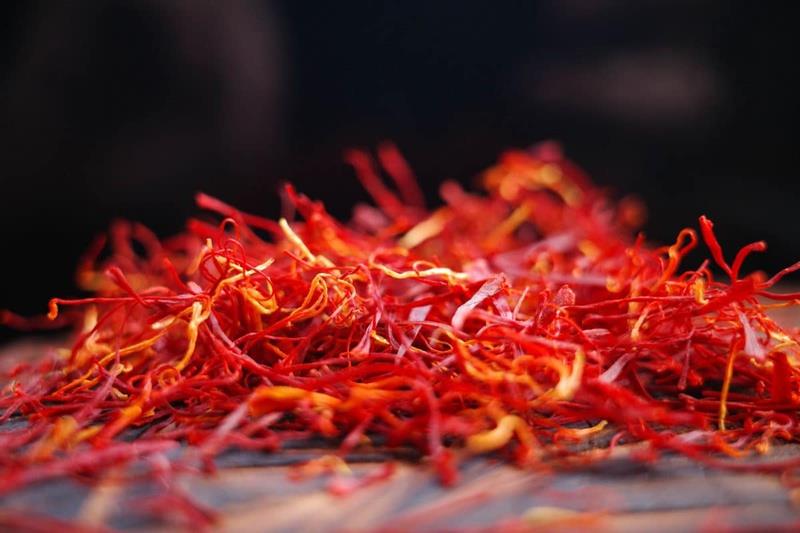How to distinguish real and fake saffron? Note when buying

Saffron has so many health and beauty benefits that it costs a fortune. Therefore, counterfeiting is inevitable. Refer to the article below to learn about how to identify saffron so as not to buy the wrong fake.
Saffron has long been a trusted natural herb and is becoming more and more popular in the market. Currently, there has been a situation where many people fake saffron and sell it at a high price with real goods, causing many people to be deceived into buying poor quality products.
 Saffron is more popular in the market
Saffron is more popular in the market
What is saffron?
Saffron is harvested from the saffron plant, which blooms only once a year, usually in late October or early November. With its thermophilic properties, this plant is well adapted to hot dry climates of countries. such as Iran, Greece, Morocco… and thrive in these countries.
Because saffron only blooms once a year, each plant has only 4 flowers and each flower has only 3 stigmas, so to harvest 1 kg of pistil, it is estimated that it needs to be harvested on about 170,000 saffron flowers.
Harvesting saffron is equally difficult. Plants only bloom for 1 to 2 weeks, during which time hundreds of thousands of workers from production facilities come to pick them. They start picking saffron early in the morning and gently remove the pistils from the flower to dry. Growing and harvesting is a very difficult and laborious process.
For these reasons, saffron is considered one of the most expensive herbs in the world.
How to distinguish the types of saffron pistil?
After classification, saffron is divided into 5 types with 5 different names and characteristics:
- Negin: Negin is the finest stamens and has the stigma removed. This is considered the best quality saffron on the market.
- Sargol: Sargol is only slightly inferior to Negin. Sargol stamens are smaller and thinner than Negin's filaments.
- Pushali: Pushali must not remove the yellow stigma to increase weight. Therefore, the quality is said to be inferior to the above two types of saffron.
- Bunch: Bunch is a type of pistil harvested whole that is bundled together, so it is difficult to check the quality of each stamen inside.
- Konji: Konji are original parts cut from the two best quality varieties mentioned above, Negin and Sargol.
Amazing benefits of saffron
Saffron offers amazing health and skin benefits:
- Skin lightening.
- Treat and prevent acne .
 Saffron helps to treat and prevent acne
Saffron helps to treat and prevent acne
- Remove tanned skin.
- Helps firm skin.
- Prevent skin aging.
- Kill death celk.
- Balances pH and maintains skin moisture.
- Helps treat depression.
- Improve eyesight .
- Reduce symptoms of Alzheimer's disease.
- Cancer treatment.
How to distinguish real and fake saffron
Saffron is very good for health, but because of the high price, many people have used fake saffron to bring high profit. If you have never bought saffron, you are very easily fooled by these sophisticated tricks. Let's refer to the ways below to distinguish real and fake saffron pistil.
Based on shape and color
Real saffron usually has a large and flat stigma, an elongated and smaller body, a dark amber red color, the stigma turns yellow-orange and gradually yellow towards the stigma.
Fake saffron usually does not have the above characteristics, short and crumbly, pistil is whole, the color is quite uniform.
Based on smell
Real saffron has a subtle aroma of hay and honey. When saffron is placed in water, the smell becomes more diffuse and more noticeable.
Fake saffron has a very mild, non-specific or even odorless odor.
Based on taste
Take 1 to 2 saffron stigmas and put them in your mouth to test, if:
- Mildly bitter with a hint of herbs and honey is real saffron.
- Sweet like honey is fake saffron.
Try the color of saffron in water
You take 3 to 5 strands of saffron and add it to the water. Real saffron takes 10 to 15 minutes to color, the water is orange or saffron yellow, very fresh. The red-orange color only appears when adding a lot of saffron pistil into the water, but the color still retains its natural freshness. Using your hands to rub the saffron pistil still retains its toughness, it may just be broken.
Real saffron takes 10 to 15 minutes for the water to turn saffron yellow
Fake saffron when put in water, the color will dissolve quickly. With only 3 to 5 pistils, in a few minutes can produce orange-red water, gradually losing color, sometimes tiny white dots appear on the pistil. When checking by hand as above, the saffron threads are crushed, no longer keeping the toughness.
Use baking soda
You can mix saffron and baking soda, then add a little water and watch. In the case of real saffron, the mixture will turn yellow, while fake saffron will form a red-orange mixture.
Above are ways to help you distinguish real and fake saffron in the market. Saffron can only be used for health and beauty care if you buy the right product, the right quality, so be very careful when buying to avoid losing money.